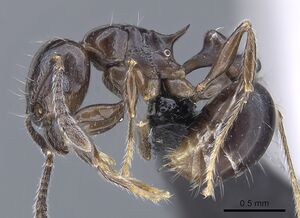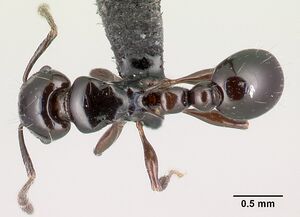Tetramorium hector
| Tetramorium hector | |
|---|---|

| |
| Scientific classification | |
| Kingdom: | Animalia |
| Phylum: | Arthropoda |
| Class: | Insecta |
| Order: | Hymenoptera |
| Family: | Formicidae |
| Subfamily: | Myrmicinae |
| Tribe: | Crematogastrini |
| Genus: | Tetramorium |
| Species: | T. hector |
| Binomial name | |
| Tetramorium hector Hita Garcia & Fisher, 2012 | |
A rarely collected species, all three of the known localities are in close proximity to each other in the northeast of Madagascar. They represent montane rainforest or rainforest habitats at elevations of 825 to 1100 m. In addition, T. hector seems to live in leaf litter. (Hita Garcia and Fisher 2012)
Identification
A member of the Tetramorium marginatum-species group
The following character combination distinguishes T. hector from the other species of the group: head longer than wide (CI 92 - 96); petiolar node in profile cuneiform, comparatively thick, and not strongly anteroposteriorly compressed dorsally; mesosomal dorsum completely unsculptured, smooth, and shiny; dark brown to black colouration.
Keys including this Species
Distribution
Occurs in Ambanizana, Ambohitsitondroina, and Anjanaharibe, northern Madagascar.
Latitudinal Distribution Pattern
Latitudinal Range: -15.17833° to -15.57167°.
| North Temperate |
North Subtropical |
Tropical | South Subtropical |
South Temperate |
- Source: AntMaps
Distribution based on Regional Taxon Lists
Malagasy Region: Madagascar (type locality).
Distribution based on AntMaps
Distribution based on AntWeb specimens
Check data from AntWeb
Countries Occupied
| Number of countries occupied by this species based on AntWiki Regional Taxon Lists. In general, fewer countries occupied indicates a narrower range, while more countries indicates a more widespread species. |

|
Estimated Abundance
| Relative abundance based on number of AntMaps records per species (this species within the purple bar). Fewer records (to the left) indicates a less abundant/encountered species while more records (to the right) indicates more abundant/encountered species. |

|
Biology
Castes
Images from AntWeb
   
| |
| Paratype of unpublished name: Tetramorium fulgidum. Worker. Specimen code casent0038428. Photographer Ryan Perry, uploaded by California Academy of Sciences. | Owned by NHMUK, London, UK. |
   
| |
| Worker. Specimen code casent0038460. Photographer Erin Prado, uploaded by California Academy of Sciences. | Owned by CAS, San Francisco, CA, USA. |
Nomenclature
The following information is derived from Barry Bolton's Online Catalogue of the Ants of the World.
- hector. Tetramorium hector Hita Garcia & Fisher, 2012: 93, figs. 131, 132, 138-140 (w.) MADAGASCAR.
Unless otherwise noted the text for the remainder of this section is reported from the publication that includes the original description.
Description
Worker
HL 0.69 - 0.78 (0.74); HW 0.64 - 0.74 (0.69); SL 0.55 - 0.60 (0.58); EL 0.15 - 0.18 (0.16); PH 0.34 - 0.38 (0.36); PW 0.51 - 0.56 (0.54); WL 0.86 - 0.97 (0.91); PSL 0.22 - 0.27 (0.25); PTL 0.18 - 0.21 (0.19); PTH 0.29 - 0.34 (0.31); PTW 0.25 - 0.29 (0.27); PPL 0.24 - 0.26 (0.25); PPH 0.29 - 0.36 (0.31); PPW 0.27 - 0.32 (0.29); CI 92 - 96 (94); SI 80 - 86 (84); OI 22 - 25 (24); DMI 58 - 62 (59); LMI 38 - 41 (39); PSLI 32 - 36 (34); PeNI 47 - 53 (50); LPeI 60 - 66 (63); DPeI 134 - 147 (140); PpNI 51 - 57 (54); LPpI 75 - 85 (81); DPpI 112 - 124 (117); PPI 100 - 113 (107) (12 measured).
Head longer than wide (CI 92 - 96). Anterior clypeal margin with median impression. Frontal carinae weakly developed, ending between posterior eye margin and posterior head margin. Antennal scrobes absent. Antennal scapes of moderate length, not reaching posterior head margin (SI 80 - 86). Eyes moderate to large (OI 22 - 25). Mesosomal outline in profile flat, strongly marginate from lateral to dorsal mesosoma; promesonotal suture and metanotal groove absent; mesosoma comparatively high, compact, and stout (LMI 38 - 41). Propodeal spines long, spinose, and acute (PSLI 32 - 36); propodeal lobes small and broadly triangular. Petiolar node in profile thickly cuneiform, approximately 1.5 to 1.7 times higher than long (LPeI 60 - 66), anterior and posterior faces not parallel, anterodorsal margin situated higher than posterodorsal, dorsum distinctly tapering backwards posteriorly; node in dorsal view between 1.3 to 1.5 times wider than long (DPeI 134 - 147). Postpetiole in profile approximately rounded and weakly anteroposteriorly compressed, approximately 1.2 to 1.3 times higher than long (LPpI 75 - 85), in dorsal view approximately 1.1 to 1.2 times wider than long (DPpI 112 - 124). Postpetiole in profile appearing slightly less voluminous than petiolar node, in dorsal view as wide as petiolar node to weakly wider (PPI 100 - 113). Mandibles mostly unsculptured, smooth, and shining, but usually few rugulae present; clypeus mostly unsculptured, smooth, and shining, few short rugulae or traces of rugulae present; cephalic dorsum between frontal carinae always with one well-developed longitudinal median ruga, often with one or two much shorter and weaker rugulae at each side, median ruga diverging approximately at eye level into two rugae running to posterior clypeal margin, median ruga much shorter than frontal carinae; lateral head only sculptured anteriorly, remainder and ventral head unsculptured. Ground sculpture on head faint to absent. Lateral mesosoma generally completely unsculptured, sometimes weak sculpture present posteriorly; dorsal mesosoma completely unsculptured, smooth, and shiny. Waist segments and gaster unsculptured, smooth, and shiny. All dorsal surfaces of body with comparatively scarce, long, erect pilosity, hairs on mesosomal dorsum not restricted to lateral margins. Body of uniform dark brown to black colour.
Type Material
Holotype worker, MADAGASCAR, Toamasina, Montagne d'Anjanaharibe, 19.5 km 27° NNE Ambinanitelo, 15.17833 S, 49.635 E, 1100 m, montane rainforest, sifted litter (leaf mold, rotten wood), collection code BLF8150, 12.-16.III.2003 (B.L. Fisher et al.) (California Academy of Sciences: CASENT0038460). Paratypes, 14 workers with same data as holotype (The Natural History Museum: CASENT0038428; CASC: CASENT0038396; CASENT0038399; CASENT0038431; CASENT0038436; CASENT0038438; CASENT0038442; CASENT0038449; CASENT0038451; CASENT0038463; CASENT0038466; Museum of Comparative Zoology: CASENT0038392; Musee d'Histoire Naturelle Genève: CASENT0038455; Naturhistorisches Museum, Basel: CASENT0038427); two workers with same data as holotype except sampled pitfall trap and collection code BLF8154 (CASC: CASENT0048692; CASENT0048694); and nine workers with same data as holotype except sampled from ex rotten stick on ground and collection code BLF8217 (CASC: CASENT0498042; CASENT0498043; CASENT0498044; CASENT0498045; CASENT0498046).
Etymology
The new species is named after the noble and heroic Trojan prince "Hector" from Greek mythology mentioned in Homer's epic poem the "Iliad". The species epithet is a noun in apposition, and thus invariant.
References
References based on Global Ant Biodiversity Informatics
- Garcia H. F. and B. L. Fisher. 2012. The ant genus Tetramorium Mayr (Hymenoptera: Formicidae) in the Malagasy regiontaxonomy of the T. bessonii, T. bonibony, T. dysalum, T. marginatum, T. tsingy, and T. weitzeckeri species groups. Zootaxa 3365: 1-123

